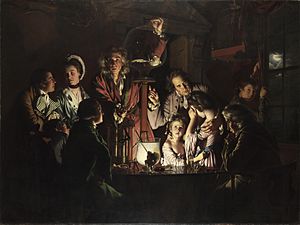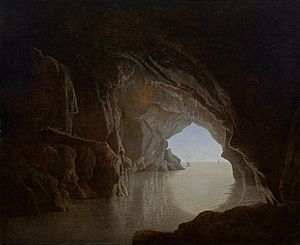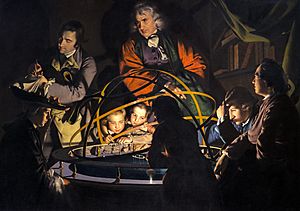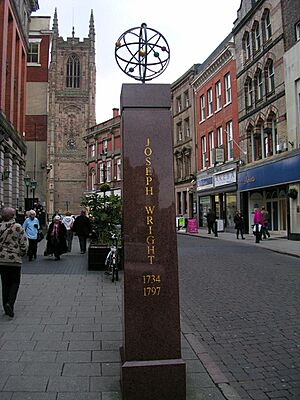Joseph Wright of Derby facts for kids
Quick facts for kids
Joseph Wright
|
|
|---|---|
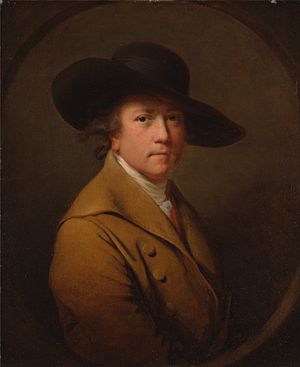
Self-portrait ca. 1780, oil on canvas,
in the Yale Center for British Art |
|
| Born | 3 September 1734 Derby, England
|
| Died | 29 August 1797 (aged 62) Derby, England
|
| Resting place | St Alkmund's Church, Derby |
| Nationality | English |
| Other names | Wright of Derby |
| Occupation | Painter |
|
Works
|
An Experiment on a Bird in the Air Pump |
| Spouse(s) |
Ann Swift
(m. 1773; |
| Children | 6 |
Joseph Wright (born September 3, 1734 – died August 29, 1797) was a famous English painter. He was known as Joseph Wright of Derby because he lived in the town of Derby. Many people say he was the first professional painter to truly show the spirit of the Industrial Revolution.
Wright was special because he used a painting style called tenebrism. This style uses strong contrasts between bright light and deep shadows, especially in his paintings lit by candles. He also painted scenes about the start of science, often showing meetings of the Lunar Society of Birmingham. This was a group of smart scientists and business people in England. His paintings show how science began to challenge older ideas during the Age of Enlightenment.
Today, many of Wright's paintings and drawings are kept by the Derby City Council. You can see them on display at the Derby Museum and Art Gallery.
Contents
Early Life and Training
Joseph Wright was born in a town called Irongate, in Derby, England. His family was well-respected, and his father was a lawyer. Joseph was the third of five children.
When he was 17, Wright decided he wanted to be a painter. In 1751, he went to London to study art. For two years, he learned from a famous teacher named Thomas Hudson. Hudson also taught another well-known artist, Joshua Reynolds. Wright also said that another artist, Alexander Cozens, influenced his ideas about how to arrange things in a painting.
After his studies, Wright returned to Derby and started painting portraits. He also worked for Hudson again for a short time. By 1753, he settled back in Derby for good. He became known for his portraits and for his unique paintings that used strong light and shadow, often from artificial light sources like candles. He also painted many landscapes. From 1768 to 1771, he spent time in Liverpool, where he painted portraits of important people and their families.
On July 28, 1773, Wright married Ann Swift. She was the daughter of a lead miner from Derbyshire.

Travels and Later Life
In 1773, Wright traveled to Italy with his wife, Ann, and two other artists. Their journey by ship was long, and they arrived in Livorno, Italy, in February 1774. While in Italy, Wright spent a lot of time in Naples. He painted many pictures of Mount Vesuvius, a famous volcano, even though he never saw a huge eruption himself. Smaller eruptions likely inspired his dramatic volcano paintings.
After his trip to Italy, Wright returned to England. He tried to set up his painting business in Bath, a popular spa town. However, he did not find much success there. In 1777, he moved back to Derby, where he lived for the rest of his life.
As he got older, Wright suffered from asthma and became very nervous. His friend, the famous doctor Erasmus Darwin, helped treat him. Through Darwin, Wright became connected to the Lunar Society of Birmingham. This group included important business leaders, scientists, and thinkers. Even though Wright was not an official member, his art was greatly influenced by the ideas of these "Midlands Enlightenment" thinkers.
Wright often showed his paintings at exhibitions. He contributed to the Society of Artists and the Royal Academy. He became an associate member of the Royal Academy in 1781 and a full member in 1784. However, he turned down the full membership because he felt he had been treated unfairly. He stopped his official connection with the Academy but continued to show his works there until 1794.
Wright's wife, Ann, passed away on August 17, 1790. They had six children together, but three of them died when they were very young. Joseph Wright himself died on August 29, 1797, at his home in Derby. He spent his last months with his two daughters.
Famous Paintings
Wright is best known for his paintings that use candlelight to create dramatic scenes. Some great examples include:
- Three Persons Viewing the Gladiator by Candlelight (1765)
- A Philosopher Lecturing on the Orrery (1766), which is at the Derby Museum and Art Gallery
- An Experiment on a Bird in the Air Pump (1768), found at the National Gallery in London
His painting Old Man and Death (1774) is also very powerful and unique.
Wright also painted beautiful landscapes. Dovedale by Moonlight shows a narrow valley near Derby at night, lit by a full moon. This painting is at the Allen Memorial Art Museum in Ohio. Its partner painting, Dovedale by Sunlight (around 1784–1785), shows the same place during the day. In another painting, Moonlight Landscape, the moon is hidden by a bridge but still lights up the water, making it sparkle. His painting Rydal Waterfall (1795) is another memorable landscape from his travels in the Lake District.
The painting Cave at Evening (shown above) also uses the strong light and shadow style, called chiaroscuro, that Wright was famous for. He painted this in 1774 while he was in Italy.
Art and the Age of Science

Joseph Wright was very close to the important business leaders of the English Midlands. Two of his biggest supporters were Josiah Wedgwood, who helped make pottery production into an industry, and Richard Arkwright, who created the factory system for making cotton. Wright also knew Erasmus Darwin and other members of the Lunar Society. This group brought together leading business people, scientists, and thinkers.
Even though the Lunar Society meetings were held near Birmingham, Darwin lived in Derby. Many of Wright's paintings, known for their bright light and deep shadows, were inspired by these meetings.
A Philosopher Lecturing on the Orrery (1766) shows an early machine that demonstrated how planets move around the Sun. Wright might have seen lectures by a Scottish scientist named James Ferguson. Ferguson used machines like the orrery to explain science. Wright might have also learned about the orrery from his neighbor, John Whitehurst, who was a clockmaker and scientist.
An Experiment on a Bird in the Air Pump (1768) shows people watching an experiment. They are learning about air and how it helps living things survive.
The Alchemist in Search of the Philosopher's Stone (1771) shows the moment a German alchemist named Hennig Brand discovered the element phosphorus in 1669. In the painting, a flask glows with light as the phosphorus, which is found in urine, catches fire when it touches air.

These paintings are not just about science; they also have deeper meanings. The glowing phosphorus in front of a praying figure can show the difficult change from old religious beliefs to new scientific understanding. The different faces of the people around the bird in the air pump show worries about whether science might become too cold or uncaring.
These paintings show a time when scientific discoveries began to challenge the power of religion in Western societies. Later, some scientists faced problems because of their ideas. For example, Joseph Priestley, a member of the Lunar Society, had to leave Britain in 1794. His laboratory was destroyed, and his house was burned down by a mob who did not like his support for the French Revolution. In France, a chemist named Antoine Lavoisier was even executed during a time of great violence.
A politician named Edmund Burke wrote that scientists like Priestley were like people who "considered man in their experiments no more than they do mice in an air pump." This makes Wright's painting of the bird in the air pump, painted more than 20 years earlier, seem very wise and ahead of its time.
It was against this background that Charles Darwin, Erasmus Darwin's grandson, would later add to the debate between science and religion. He published his famous book The Origin of Species in 1859.
Memorials
Joseph Wright's birthplace at 28 Irongate, Derby, is remembered with a special design on the pavement. It shows an armillary sphere, which is a model of objects in the sky.
Wright was buried in the churchyard of St Alkmund's Church, Derby. However, the church was taken down in 1968 to build a new road. Wright's remains were moved to another cemetery. In 1997, his tombstone was placed next to Derby Cathedral. In 2002, it was moved inside the Cathedral and put on a wall near a well-known memorial.
A school in Derby is also named after Joseph Wright. The Joseph Wright Centre opened in 2005 as a new main building for Derby College. It is named after the painter because his "artwork captured the many scientific and technological advances of the Industrial Revolution."
In 2013, the Derby City Council announced they would put a blue plaque on his home at 27 Queen Street in Derby. This plaque would mark it as a historically important building.
Other Works
- Vesuvius from Posillipo by Moonlight (1774)
- Grotto by the Seaside in the Kingdom of Naples with Banditti, Sunset (1778) at the Museum of Fine Arts, Boston
- Peter Labilliere (1780) at Dorking Museum, UK
- Indian Widow (1784)
- Miss Mary Tunaley (1790–93) at the Museum of Fine Arts, Boston
- Romeo and Juliet: the Tomb Scene (1790) at the Derby Museum and Art Gallery
- Virgil's Tomb (three versions, 1779 to 1785)
See also
 In Spanish: Joseph Wright para niños
In Spanish: Joseph Wright para niños


